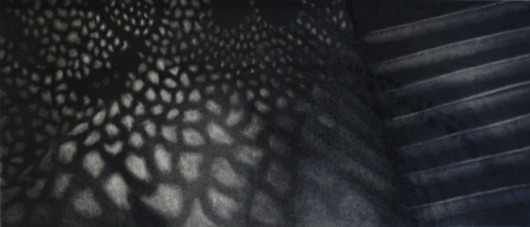“Feminism isn’t about making women stronger. Women are already strong. It’s about changing the way the world perceives that strength.”
G.D Anderson, 2015
In her paintings, Pip Dickens employs innovative methods to create unusual surfaces, layers and textures. Depth and surface contrasts are particularly important, and her work draws on many sources. This includes natural phenomena to the darker elements of phantasmagoria, from opacity to transparency, from rhythms within music to pattern structures in nature, from cinematic devices to literary sources. Concerned with visual perception Dickens examines and challenges theories and methodologies of light and movement within the second dimension. Concepts of illusion and double meaning are recurring themes. The notion that we may receive two contrasting visual or intellectual responses to a single stimulant.
Dickens’ painterly practice also reflects upon female characters, fabrics, motifs and patterns, creating a captivating ocular experience within the picture plane through surface interest and cinematic 'letterbox' formats. With the paintings ‘Mrs Danvers’ and ‘Madame Bovary’, she raises questions about death, desire, greed and madness that surrounds the female character. Her ‘Femme Fatale’ series epitomises both liberated and tormented onscreen women engaged with misogynistic, hard-hearted and cynical male stereotypes. Las Meninas reflects on Margarita Teresa, who was married off to her Uncle and first cousin, Leopold I: Holy Roman Emperor, King of Hungary, Croatia, and Bohemia at the age of 15 and died at 21 years following illness and weakened by four childbirths and miscarriages.
We are familiar with Daphne du Maurier’s novel ‘Rebecca’, published in 1938. Mrs Danvers is the sinister housekeeper at the stately manor Manderley belonging to the wealthy Maximillian de Winter. She was deeply devoted to the first Mrs de Winter, Rebecca, who died in a boating accident about a year before her husband and the second Mrs de Winter met. Danvers resents the new Mrs. de Winter and attempts to persuade her to leap to her death.
‘Madame Bovary’ published by Gustave Flaubert in 1856. The character, Charles Bovary (an Officer de santé) marries Emma Rouault after the unexpected death of his first wife Héloïse Dubuc. Married life and motherhood proves to be a disappointment for Emma, even after moving to the larger market town of Yonville. She becomes infatuated with Léon Dupuis a young law student and later with the rich landowner Rodolphe Boulanger. Both relationships do not provide the fulfilment and happiness Emma was yearning. Her indulgence for extravagance brings vast debts and led to her death after she had swallowed arsenic.
Dickens’ ‘Femme Fatale’ series are charcoal drawings that reference Film Noir and seductive fabrics like silks and lace, worn by femme fatale characters of the genre. These creatures achieve their hidden purpose by using feminine trickeries such as beauty, charm, or sexual allure. Their attitude towards sexuality is laissez-faire, intriguing, or frivolous. On the one hand, these ladies are masters of deception and intimidation, on the other hand they can also be victims, caught in a situation from which they cannot escape. Femme fatales have epitomised liberated onscreen women engaged with misogynistic, hard-hearted and cynical male stereotypes.
Dickens’ ‘Las Meninas’ paintings reference Velazquez commissioned portraits in particular ‘Infanta’, Margarita Teresa in a pink dress. The depictions of Margarita Teresa were both for the court and to send to the court of Leopold, as early as 1653 when Margarita Teresa was just 2 years old.
Her response focuses on the guarding of the precious political chattel - Margarita Teresa. Are they benevolent guards or wardens – caring protectors but charged with her restriction? Just as the fashionably exaggerated guardainfante, a bulkier-style farthingale of French origin (hooped structure worn under the gown), imprisons the little princess, the restriction of space, reach and isolation are contained within this silken cage.
The more we study these paintings and drawinsg and their subject, the less we see privilege and care, rather, a holding cell-populated with amusements and distractions. In her visual interpretation the young princess custodians are transformed into Doberman Pinschers a renowned breed whose qualities are intelligence, fearlessness, loyalty, obedience and above all the most vigilant guard dog.
What connects these women? What do they share despite their different fate, character and age? Misery and suffering were in abundance in the existence of the jealous Mrs Danvers and the luxury obsessed Madame Bovary. And the young life of Margarita Teresa was cut-short after much physical and emotional agony and abuse. Whereas Dickens’ contrasting ‘Femme Fatale’ drawings signal impressions of a seductress in control of her life and destiny.
Pip Dickens has a Masters in Fine Art from The Slade School of Art, University College London, graduating in 2000. She is a Lecturer in Painting at Lancaster University. In 2010-2011 she was awarded the Leverhulme Trust Award Artist in Residence at the University of Huddersfield, Department of Music collaborating with composer, Professor Monty Adkins on synergy between music and painting through research of Japanese aesthetics. She also undertook research in Kyoto, Japan and co-authored a book ‘Shibusa - Extracting Beauty’ with Professor Monty Adkins. Her Femme Fatale drawings are in the collection of The Arch Hotel, London. Dickens has exhibited widely in the UK and internationally and is currently exhibiting paintings from her ‘Screen ‘ and ‘Shibusa’ series of paintings at Cheer Bell Gallery, Hong Kong until the end of August 2020.
For further information about Pip Dickens' work contact [email protected]
Newsletter:
Courtesy and ©Pip Dickens and Renée Pfister (text), 2020.
Video:
Courtesy and ©Pip Dickens, Ben Sound (music) https://www.bensound.com/royalty-free-music/track/epic and Renée Pfister (text), with the assistance of Galina Matveeva, 2020. All rights reserved.
Image:
Pip Dickens, Femme Fatale V, 2007, charcoal on paper drawing, H233 mm x W555 mm.
